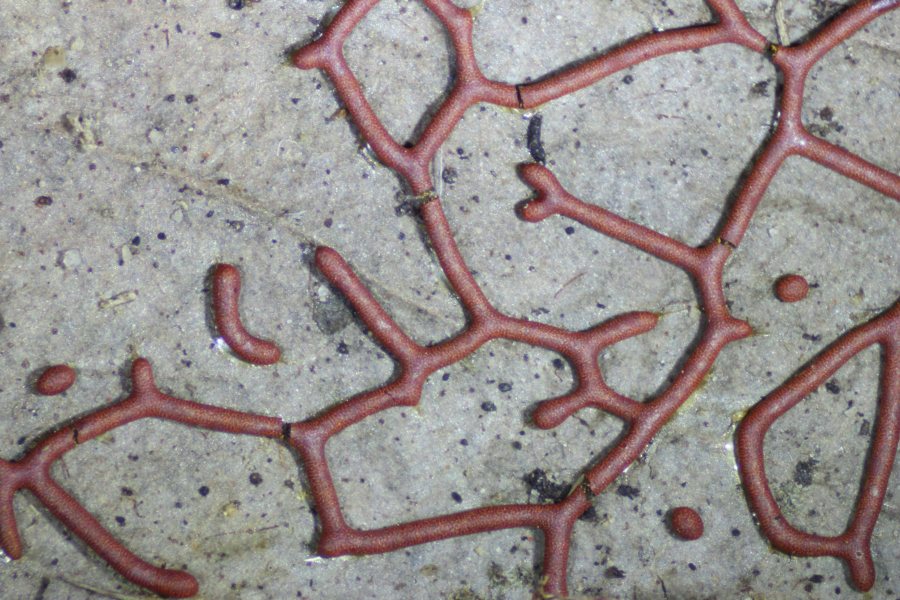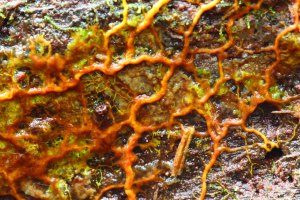aethalium (pl. aethalia) a relatively large, stalkless, rounded fruiting body formed from all or most of the plasmodium – e.g. Fuligo septica
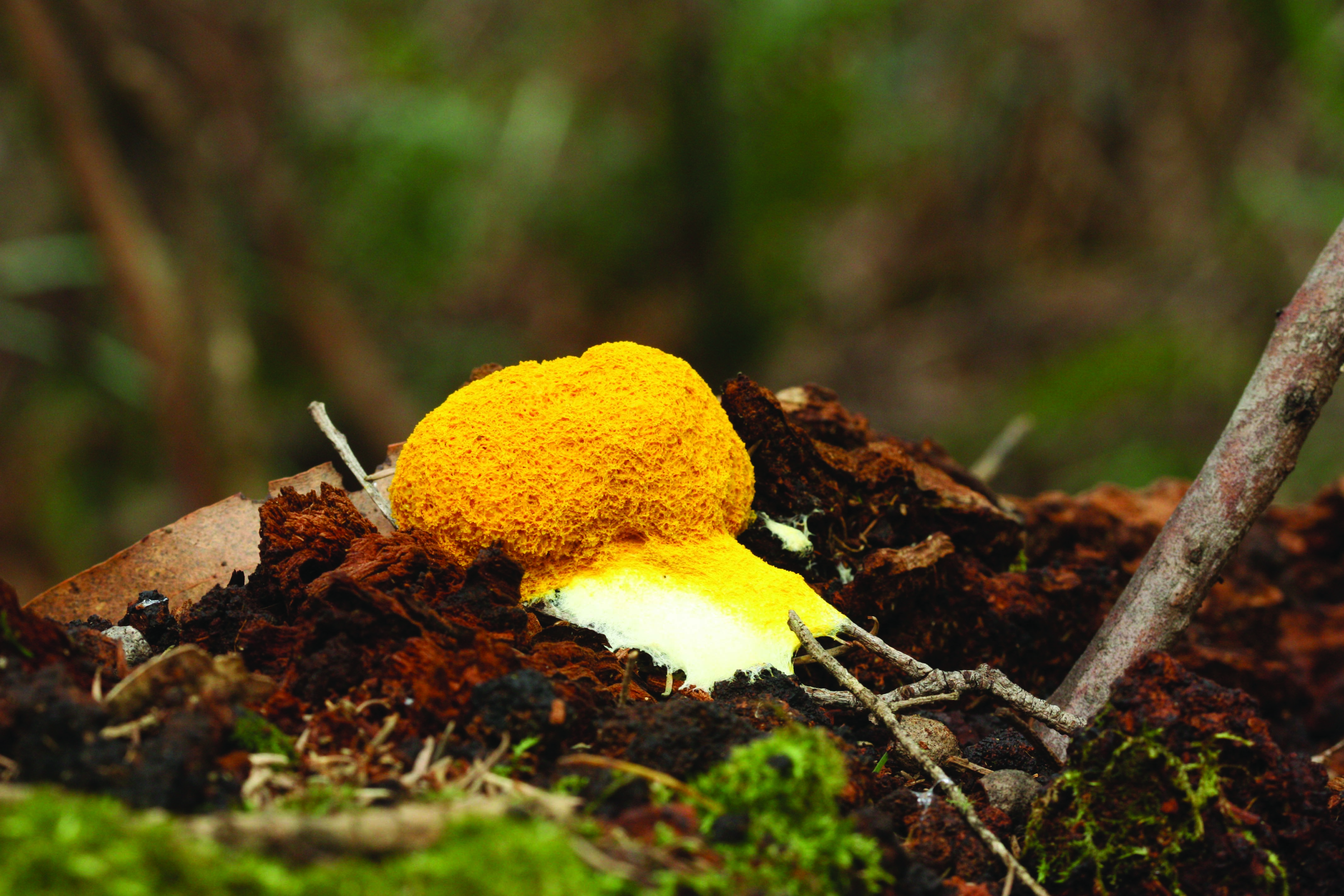
aphanoplasmodium (pl. aphanoplasmodia) usually invisible (aphano=invisible) type of plasmodium characteristic of members of the Stemonitidales. Some come to the surface and are visible before they form fruiting bodies.

calyculus (pl. calyculi) persistent cup-like structure formed from the base of the peridium. It surrounds the base of the spore mass.
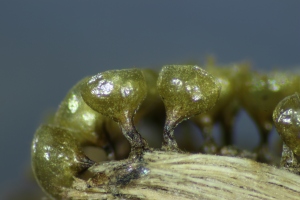
capillitium (pl. capillitia) sterile thread-like structures found within the spore mass of some slime moulds.


columella an extension of the stalk inside the sporotheca.
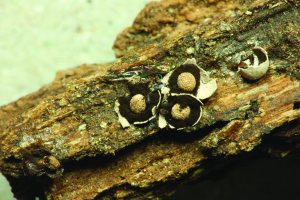

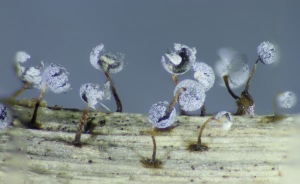
cortex thick, usually hard covering of the spore mass of an aethalium.

dehiscent bursting or splitting open at maturity to release spores.
evanescent ephemeral or transitory.
frass material that results from the chewing actions of phytophagous (i.e. plant-eating) insects. It can be powdery, but more often it resembles tiny pellets of plant fragments.
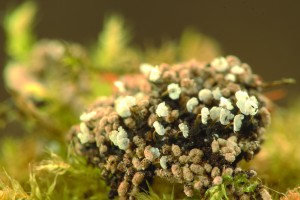
fugacious withering or dropping off early.
fructification also called fruiting body.
hypothallus thin membrane (often inconspicous) or limey layer deposited by the plasmodium at the time of fruiting.

lenticular lens shaped.
meiosis the process of cell division in sexually reproducing organisms that reduces the number of chromosomes in reproductive cells from diploid to haploid, leading to the production of gametes in animals and spores in plants.
micrometer (μm) 1/1000 of a millimetre or 10¯⁶ metres.
myxamoeba (pl. myxamoebae) microscopic uninucleate amoeboid trophic stage in the life cycle of a myxomycete; may also function as gamete.
myxocarp spore-producing structure, i.e. fruiting body, of myxomycete.
nivicolous or snowbank species are found at the edge of melting snow in regions that have at least 3 months of snow each year.
obligate applies to an organism that can survive only if a particular environmental condition is satisfied.
ostiole an opening through which spores are dispersed.
palladium a soft silver/white metal that resembles platinum.
peridium membrane that encases the spores; can be limey, persistent, iridescent or evanescent.
perithecium (pl. perithecia) a small flask-shaped fruiting body in ascomycetous fungi that contains the ascospores.
phaneroplasmodium (pl. phaneroplasmodia) type of plasmodium that is usually conspicuous, characteristic of members of the Physarales.
phenotypic plasticity the ability of an organism to change its phenotype (observable traits, behaviour etc.) in response to changes in the environment.
plasmodiocarps fruiting bodies that resemble veins in the plasmodium.
Plasmodiocarp of Willkommlangea reticulata (see end)
plasmodium (pl. plasmodia) acellular, multinucleate mass of protoplasm that is the main feeding stage of the myxomycete.
protoplasmodium (pl. protoplasmodia) type of plasmodium that is microscopic and gives rise to usually one small fruiting body.
pseudoaethalium (pl. pseudoaethalia) resemble aethalia, but are actually composed of individual, closely-packed sporangia.

pseudocapillitium (pl. pseudocapillitia) irregular plates, tubes or thread-like elements within spore mass of aethalia; like capillitia but not formed in the same way.
pseudopodia (Gk pseudes false; podos foot) a protusion, usually temporary, that functions in locomotion and ingestion of food.
pulvinate cushion-shaped; having shape of small cushion.
rachis central stalk of fern.
resupinate lying flat on a surface.
reticulate like a net.
SEM scanning electron microscope.
sessile without a stalk.
sporangium (pl. sporangia) type of fruiting body formed when a plasmodium breaks up into a number of small portions which develop into stalked or sessile units.

sporophore term sometimes used for sporangium; some authors use this term only for myxos bearing external spores, e.g Ceratiomyxa fruticulosa.
sporotheca (pl. sporothecae) part of sporangium that contains the spores, sometimes called sporocyst or spore mass.
stipe stalk.
substratum (pl. substrata) the material on which something appears/grows. E.g. soil, rock, bark, leaves etc.
subulate narrowing to a point from a wide base.
swarm cells (or swarmers) microscopic uninucleate flagellated trophic stage in myxomycete life cycle; may also function as a gamete.
syngamy the union of nuclei of two gametes to produce a zygote nucleus following fertilisation.
trophic of or involving the feeding habits or food relationship of different organisms in a food chain.
type specimen original specimen used by an author to describe a new species, subspecies or variety (also known as holotype).
vacuole a membrane-bound sac.
zygote fertilised ovum, formed from fusion of male and female gametes.
